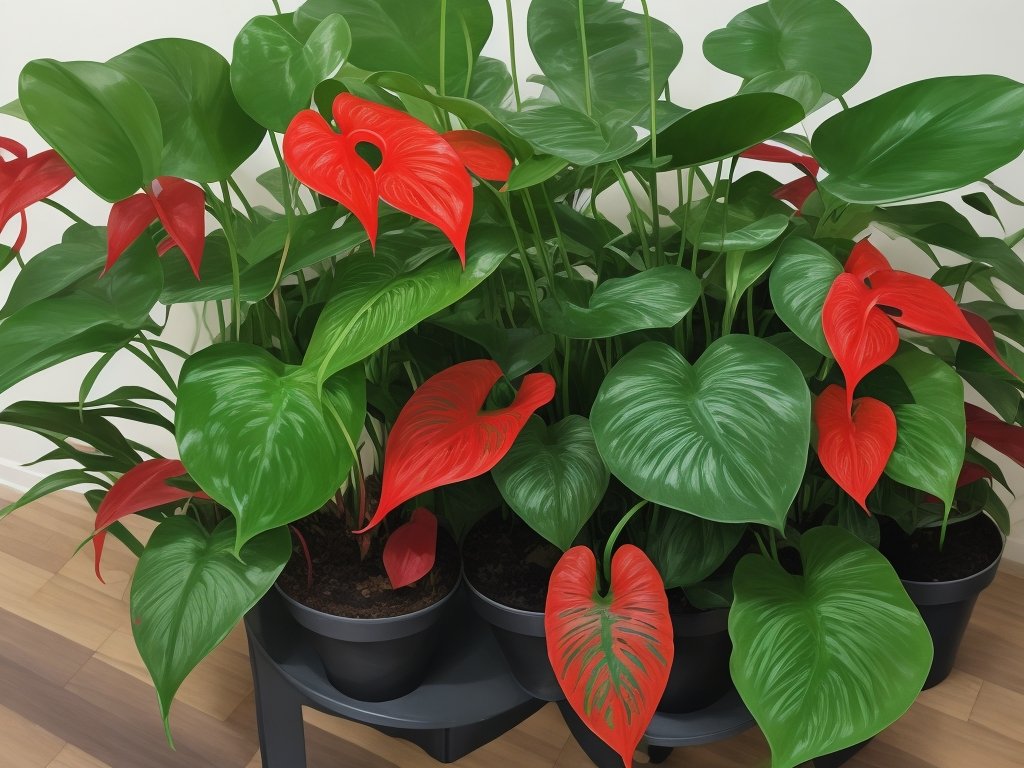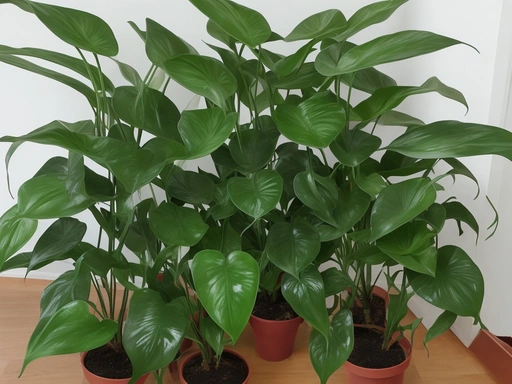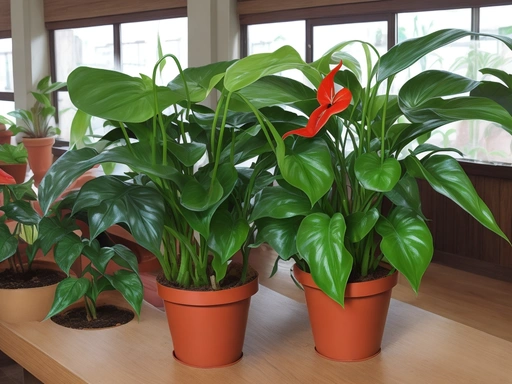Anthurium Seasonal Changes: The Perfect Plant for Every Occasion!
Key Takeaways:
- Anthurium plants experience seasonal changes in their growth and blooming patterns.
- Temperature and light play a significant role in regulating Anthurium’s seasonal changes.
- Cold temperatures can cause Anthurium’s growth and blooming to slow down or even halt.
- Providing the right conditions, such as consistent warmth and optimal light levels, can help promote year-round growth and flowering in Anthurium plants.
Have you ever wondered why your Anthurium plants seem temperamental, thriving in one season but struggling in another?
Well, you’re not alone.
Understanding the seasonal changes that impact Anthurium growth is key to maintaining their health year-round.
In this article, we’ll delve into the world of Anthuriums and explore how they grow, the role of seasons in their growth, and the effects of temperature and light.
We’ll also discuss how to care for Anthuriums in specific seasons, how to protect them from common challenges, and provide expert tips for maintaining their health.
So, whether you’re a seasoned Anthurium enthusiast or just starting out, stay tuned for valuable insights and answers to your burning questions.
| Season | Description |
|---|---|
| Spring | Flowering Season: Anthuriums typically bloom during spring, producing vibrant and showy flowers. |
| Summer | Growth Period: In summer, anthuriums experience rapid growth, with increased foliage and root development. |
| Fall | Fruit Development: During fall, anthuriums may develop fruit, which can take several months to ripen. |
| Winter | Dormant Period: Anthuriums enter a dormant period in winter, which means they require less water and fertilizer and may experience slower growth. |
Understanding Anthurium Seasonal Changes
Understanding Anthurium Seasonal Changes is important to ensure successful growth and blooming of these plants.
What are Anthuriums?
Anthuriums are beautiful flowering plants that are native to the tropical regions of America. They are known for their vibrant and long-lasting flowers, which come in a variety of colors like red, pink, and white.
Anthuriums are popular indoor plants due to their unique heart-shaped leaves and are relatively easy to care for.
How do Anthuriums Grow?
Anthuriums grow from rhizomes, which are thick, horizontal stems that produce roots and shoots.
They prefer well-draining soil and bright, indirect light.
Regular watering and high humidity levels are important for their growth.
Fertilizing every two to four weeks during the growing season can also promote healthy growth.
Propagation can be done through division or stem cuttings.
Overall, providing the right conditions and care will help Anthuriums thrive and grow.
The Role of Seasons in Anthurium Growth
The different seasons play a significant role in the growth of Anthurium plants.
In spring and summer, they thrive in warmer temperatures and longer daylight hours, resulting in increased growth and blooming.
In fall and winter, Anthuriums enter a dormant phase, requiring less light and water.
Understanding these seasonal changes helps in providing the right care, protecting them from extreme temperatures, and ensuring their overall health and well-being throughout the year.
The Impact of Temperature on Anthuriums
The temperature has a significant impact on the growth and development of Anthuriums.
These plants thrive best in temperatures between 60-85°F (15-29°C).
Extreme heat above 90°F (32°C) can cause wilting and sunburn, while temperatures below 50°F (10°C) can stunt growth and damage the plant.
Maintaining a consistent temperature within the ideal range is crucial for the overall health of Anthuriums.
The Effect of Light on Anthurium Growth
The amount and quality of light greatly impact the growth of Anthuriums.
These plants thrive in bright, indirect light.
Direct sunlight can scorch their leaves, while insufficient light can lead to weak growth and lack of blooming.
Place Anthuriums near a window with filtered sunlight or use artificial grow lights.
Ensure they get 6-8 hours of light each day.

Anthuriums in Spring and Summer
In Spring and Summer, caring for Anthuriums involves adjusting watering and fertilizing routines to accommodate the warmer weather.
How to Care for Anthuriums in Spring and Summer
During spring and summer, caring for anthuriums involves paying attention to watering, lighting, and fertilizing.
Make sure to water your anthuriums thoroughly but allow the soil to dry out between waterings.
Provide bright indirect light, but avoid direct sunlight.
Fertilize every two to four weeks with a balanced liquid fertilizer.
Keep an eye out for pests like aphids or spider mites, and treat them promptly.
Overall, maintaining consistent care will ensure healthy growth for your anthuriums during these seasons.
Dealing with Pests and Diseases in Warmer Months
During the warmer months, anthuriums are more susceptible to pests and diseases.
To deal with this, it’s important to regularly inspect your plants for any signs of infestation or illness.
If you notice any pests, such as aphids or spider mites, you can gently wash them off with a strong stream of water or use an insecticidal soap.
For diseases like root rot or fungal infections, ensure proper drainage and avoid over-watering.
Using a fungicide might also be necessary.
Taking preventive measures like maintaining good hygiene, providing adequate airflow, and keeping the plant healthy will help protect your anthuriums during this time.
Anthuriums in Fall and Winter
Anthuriums may require special care during the fall and winter seasons due to changes in temperature and light conditions.
Preparing Anthuriums for the Colder Months
To prepare Anthuriums for colder months, it’s important to protect them from frost and cold temperatures.
This can be done by moving them indoors or providing insulation.
Additionally, adjusting watering and fertilizing routines to accommodate reduced growth during this time can help ensure the health and survival of your Anthurium plants.
Protecting Anthuriums from Frost and Cold Temperatures
To protect Anthuriums from frost and cold temperatures, there are a few key steps you can take.
First, bring your Anthuriums indoors if possible, as they are sensitive to extreme cold.
If keeping them inside isn’t an option, consider covering them with a frost cloth or blanket overnight when temperatures drop.
Additionally, avoid overwatering your Anthuriums during colder months, as wet roots are more prone to freezing.
With these precautions, you can help safeguard your Anthuriums from the damaging effects of frost and cold temperatures.

Common Challenges in Fall and Winter
During fall and winter, common challenges for Anthuriums include lower light levels and colder temperatures. This can result in slower growth, decreased blooming, and increased susceptibility to pests and diseases.
Additionally, overwatering can become an issue as the plants require less water during these seasons.
It’s important to adjust your care routine accordingly and provide adequate lighting, protect against cold temperatures, and avoid overwatering.
Tips for Maintaining Anthurium Health Year-Round
To keep your Anthuriums healthy all year long, focus on watering them properly, fertilizing at the right time, and propagating for future seasons.
Watering Anthuriums Properly
Watering Anthuriums Properly: To keep your anthurium healthy, it’s important to water it correctly.
Here are some tips:
- Allow the top inch of soil to dry out before watering again. Overwatering can lead to root rot.
- Use room temperature water. Cold water can shock the plant.
- Water the soil directly, avoiding the leaves and flowers. Wet foliage can invite fungal diseases.
- Choose a well-draining potting mix to prevent waterlogging.
- Water less during the cooler months when the plant is in a resting phase.
Remember, each plant’s watering needs may vary slightly, so observe your anthurium and adjust accordingly.
Fertilizing Anthuriums at the Right Time
Fertilizing Anthuriums at the right time is essential for their health.
I recommend fertilizing during the active growing seasons of spring and summer.
Use a balanced fertilizer diluted to half strength every month.
In fall and winter, reduce fertilization or stop altogether since the plants are in a resting phase.
Always follow the instructions on the fertilizer packaging and avoid over-fertilization, which can harm the plants.

Propagating Anthuriums for Future Seasons
To propagate Anthuriums for future seasons, you can use two methods: division or stem cuttings.
- Division: Gently separate the plant into smaller sections, making sure each section has roots and leaves. Then, replant the divisions in their own pots.
- Stem cuttings: Cut a healthy stem with two to three nodes and remove the bottom leaves. Dip the cut end in rooting hormone and plant it in a well-draining soil mix. Keep the soil consistently moist until roots develop.
Both methods require proper care, such as providing adequate light, warmth, and humidity.
With these techniques, you can expand your Anthurium collection and enjoy their beauty in future seasons.
Frequently Asked Questions about Anthurium Seasonal Changes
Can Anthuriums Survive in Cold Climates?
Yes, Anthuriums can survive in cold climates, but they are not frost-tolerant.
If exposed to freezing temperatures, they can suffer damage or even die.
It’s important to protect them during winter by bringing them indoors or providing them with adequate insulation.

Do Anthuriums Need Special Care during Seasonal Transitions?
Anthuriums do require some special care during seasonal transitions.
As the weather changes, it’s important to adjust your watering and fertilizing routine to accommodate the plant’s needs.
Additionally, you may need to protect your anthuriums from extreme temperatures or provide extra lighting during darker months.
With a little extra attention, your anthuriums can thrive throughout the year.
Are There Any Varieties of Anthuriums That Thrive in All Seasons?
Yes, there are certain varieties of Anthuriums that can thrive in all seasons. One example is the Anthurium clarinervium, which is known for its ability to withstand different temperature and light conditions.
Another variety is the Anthurium andraeanum, which is more commonly found and can also adapt well to varying seasons.
These varieties have characteristics that make them resilient and adaptable to different environments throughout the year.
How Often Should Anthuriums be Repotted?
Anthuriums should be repotted every 2-3 years or when they outgrow their current container.
It’s important to choose a slightly larger pot to allow for growth.
Be gentle when repotting to avoid damaging the roots.
Final Verdict
Understanding the seasonal changes that impact Anthurium growth is crucial for their overall health and longevity.
From temperature to light exposure, each season presents its unique challenges and opportunities for these beautiful plants.
By providing the right care during each season, such as proper watering, fertilization, and protection against pests and diseases, Anthuriums can thrive year-round.
It is also important to consider the specific needs of Anthuriums during fall and winter, including protecting them from frost and adapting their care routine accordingly.
By following these tips and maintaining a consistent care regimen, Anthurium owners can enjoy beautiful, healthy plants throughout the year.






